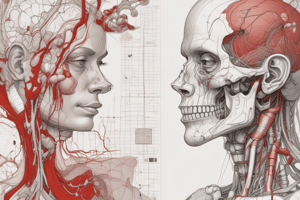Podcast
Questions and Answers
What is the primary function of albumin in plasma?
What is the primary function of albumin in plasma?
- Coagulation of blood
- Antibody formation
- Transporting hormones and metals
- Influencing colloidal osmotic pressure (correct)
Which of the following is NOT a function of plasma proteins?
Which of the following is NOT a function of plasma proteins?
- Maintaining acid-base balance
- Acting as a protein reserve
- Digesting proteins (correct)
- Regulating blood viscosity
What is the role of fibrinogen in the blood?
What is the role of fibrinogen in the blood?
- Maintaining colloidal osmotic pressure
- Antibody formation
- Coagulation of blood (correct)
- Transporting hormones and metals
What is the function of alpha and beta globulins?
What is the function of alpha and beta globulins?
What influences the erythrocyte sedimentation rate (ESR)?
What influences the erythrocyte sedimentation rate (ESR)?
What is responsible for creating a negative charge on the surface of RBCs?
What is responsible for creating a negative charge on the surface of RBCs?
What is the unit of measurement for erythrocyte sedimentation rate (ESR)?
What is the unit of measurement for erythrocyte sedimentation rate (ESR)?
What is the significance of plasma proteins acting as buffers?
What is the significance of plasma proteins acting as buffers?
What is the function of gamma globulins in the body?
What is the function of gamma globulins in the body?
What happens to plasma proteins during emergencies?
What happens to plasma proteins during emergencies?
Flashcards are hidden until you start studying
Study Notes
Blood Composition and Functions
- Blood is a fluid that circulates in the vascular channels of the human body due to the pumping action of the heart.
- Blood consists of a liquid portion called plasma in which various types of cells are present.
- The cells suspended in the plasma are of three different types:
- Erythrocytes (red blood cells) containing hemoglobin, which gives them their red color.
- Leucocytes (white blood cells) of different types (5).
- Thrombocytes (platelets) responsible for blood coagulation.
General Functions of Blood
- Respiratory function: transport of oxygen from lungs to tissues and carbon dioxide from tissues to lungs.
- Excretory function: transport of waste products to kidneys, lungs, skin, and gastrointestinal tract for excretion.
- Nutritive function: transport of digested food substances to all parts of the body.
- Defensive function: protection of the body against infections through phagocytosis by leucocytes.
- Coagulation function: formation of a clot to prevent blood loss.
- Acid-base equilibrium function: maintenance of a constant pH through buffers in the blood.
- Body temperature regulation function: maintenance of body temperature due to the high specific heat and latent heat of evaporation of blood.
- Transport of substances function: rapid circulation of blood enables easy transport of hormones, vitamins, and drugs throughout the body.
- Protein reserve function: plasma proteins can act as a protein reserve and be used in extreme protein deficiency to form cell proteins.
Blood Components
- Water: 93-95% (plasma), 65-68% (RBC), and 81-86% (whole blood).
- Electrolytes: Na+, K+, Mg2+, Cl-, HCO3-, etc.
- Proteins:
- Albumin (40-48 g/L): carrier, buffer, and colloid osmotic pressure.
- Globulin (15-30 g/L): immune reaction, antibody, and carrier.
- Fibrinogen (2-4 g/L): blood coagulation.
- Hemoglobin (Hb): 120-160 g/L (male), 110-150 g/L (female).
- Others: carbohydrates, lipids, amino acids, pigments, hormones, gases (O2, CO2), and waste products (urea, uric acid, etc.).
Plasma
- Plasma is the fluid part of the blood in which formed elements are suspended.
- Plasma contains 91-92% water and 8-9% of solid substances (organic and inorganic).
- Organic substances in plasma include:
- Plasma proteins (6.5-8 g%): albumin, globulin, and fibrinogen.
- Glucose (80-120 mg%).
- Cholesterol and lipids (150-250 mg%).
- Non-protein nitrogenous substances like urea, uric acid, creatine, and creatinine.
- Hormones, enzymes, and blood pigments.
Plasma Proteins
- Albumin: 4-4.5 g% of plasma proteins, molecular weight 60,000, responsible for colloidal osmotic pressure.
- Globulin: 2.5 g% of plasma proteins, molecular weight 130,000, involved in antibody formation and blood coagulation.
- Fibrinogen: 0.25 g% of plasma proteins, involved in blood coagulation.
Functions of Plasma Proteins
- Colloidal osmotic pressure.
- Antibody formation.
- Coagulation.
- Transport media.
- Erythrocyte sedimentation rate (ESR).
- Viscosity.
- Buffer mechanism.
- Protein reserve.
Erythrocyte Sedimentation Rate (ESR)
- Measures the speed of sedimentation of RBC/RBC aggregates in plasma over a period of 1 hour.
- Influenced by the fibrinogen content of plasma.
- Non-specific laboratory test used to measure inflammation or disease activity.
Studying That Suits You
Use AI to generate personalized quizzes and flashcards to suit your learning preferences.




